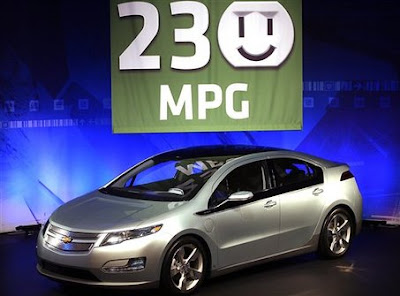
"As the global market for electrified vehicles grows rapidly over the next several years, lithium ion (Li-ion) batteries in a variety of chemistries will be the technology of choice for auto manufacturers." - this is the most important take out for us and our investment strategy from this report. We have mentioned before that auto makers have confirmed this choice of Lithium-ion technology on a number of auto shows. Another important message is a growth rate of this market expected by this company: from $878 million estimated in 2010 to 8 billion in 2015. It means an explosive growth for Lithium Demand if these estimations are valid. Big stakes will be taken in the big game. More about introduction to the sector is in "BBC Rare earth: The New Great Game"

The U.S. government is looking to give out a second $100 million funding round to developers of fuels and batteries for electric cars.
The U.S. Department of Energy has another $100 million to give to cutting-edge research, and it's focus remains on accelerating electric car deployment.
The DOE said Monday it's looking for projects in transportation, liquid fuel and batteries as part of its second round of funding from the Advanced Research Projects Agency-Energy (ARPA-E). The America Competes Act of 2007 created the ARPA-E, which is meant to support sciences that could make a significant contribution to the national goals of reducing foreign oil imports and emissions, and promoting energy efficiencies.
The DOE awarded its first round, $151 million to 37 projects back in October. At the time, $23.7 million of the funding went to startups and universities to investigate ways to make liquid transportation fuels from using sunlight as a key ingredient or even act as a catalyst (see New Form of Solar Energy: Direct Solar Fuel).
For example, BioCee and the University of Minnesota, which received the money from the previous round, are looking at using sunlight and carbon dioxide to grow two organisms for producing hydrocarbon.
Another company, Sun Catalytix, plans to use solar electricity to split water for producing hydrogen, which could be used as a car fuel or fed to fuel cells for electricity generation for homes and businesses at night (see Hydrogen-Harvesting Catalysts From the Sun).
For the latest round of funding, the DOE is again looking for similar, sunlight-to-fuel projects. But instead of projects that rely on the sun, typically for photosynthesis, the DOE wants to fund research that could use engineered microbes to convert carbon dioxide to fuels.
The use of photosynthesis is innovative, but the "overall efficiencies remain low," the DOE said. Plus, the need for sunlight also would limit production to during the day.
Specifically, the DOE is looking for projects to develop microbes that can harvest energy from hydrogen, metal ions or from electric current.
Besides liquid fuel projects, the DOE also wants to fund battery technologies for electric cars, as well as materials and methods to capture carbon dioxide emissions at coal-fired power plants.
Carbon capture remains a focus of various types of DOE funding, given that roughly 50 percent of the country's electricity come from coal-fired power plants."
The U.S. Department of Energy has another $100 million to give to cutting-edge research, and it's focus remains on accelerating electric car deployment.
The DOE said Monday it's looking for projects in transportation, liquid fuel and batteries as part of its second round of funding from the Advanced Research Projects Agency-Energy (ARPA-E). The America Competes Act of 2007 created the ARPA-E, which is meant to support sciences that could make a significant contribution to the national goals of reducing foreign oil imports and emissions, and promoting energy efficiencies.
The DOE awarded its first round, $151 million to 37 projects back in October. At the time, $23.7 million of the funding went to startups and universities to investigate ways to make liquid transportation fuels from using sunlight as a key ingredient or even act as a catalyst (see New Form of Solar Energy: Direct Solar Fuel).
For example, BioCee and the University of Minnesota, which received the money from the previous round, are looking at using sunlight and carbon dioxide to grow two organisms for producing hydrocarbon.
Another company, Sun Catalytix, plans to use solar electricity to split water for producing hydrogen, which could be used as a car fuel or fed to fuel cells for electricity generation for homes and businesses at night (see Hydrogen-Harvesting Catalysts From the Sun).
For the latest round of funding, the DOE is again looking for similar, sunlight-to-fuel projects. But instead of projects that rely on the sun, typically for photosynthesis, the DOE wants to fund research that could use engineered microbes to convert carbon dioxide to fuels.
The use of photosynthesis is innovative, but the "overall efficiencies remain low," the DOE said. Plus, the need for sunlight also would limit production to during the day.
Specifically, the DOE is looking for projects to develop microbes that can harvest energy from hydrogen, metal ions or from electric current.
Besides liquid fuel projects, the DOE also wants to fund battery technologies for electric cars, as well as materials and methods to capture carbon dioxide emissions at coal-fired power plants.
Carbon capture remains a focus of various types of DOE funding, given that roughly 50 percent of the country's electricity come from coal-fired power plants."
No comments:
Post a Comment